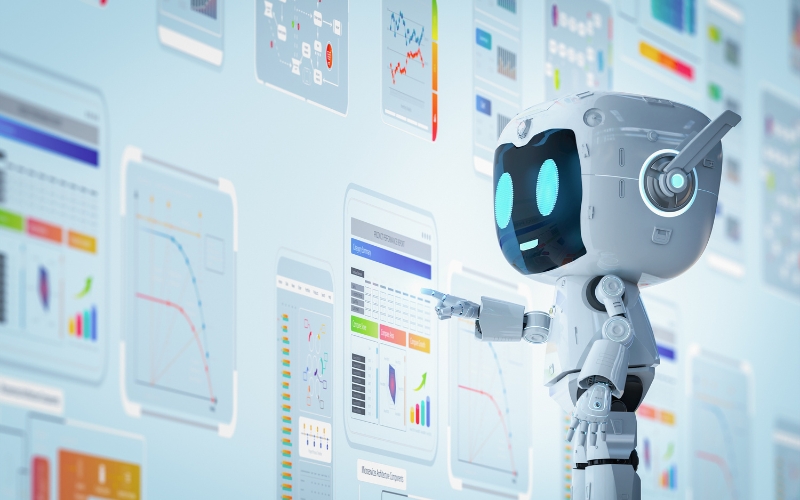The role of Artificial Intelligence (AI) in website development has expanded rapidly in recent years, revolutionizing various aspects of the process, from design to coding and performance optimization. AI technologies are not just streamlining repetitive tasks, but are also enhancing user experiences by automating design elements, personalizing content, and improving site performance. Whether through AI-powered design tools that create visually appealing and user-centric layouts, personalized recommendations that boost user engagement, or predictive analytics that optimize website performance, AI is playing an integral part in shaping the future of web development. In this article, we will explore how AI is transforming website design, personalization, and development, making it easier for businesses to deliver high-quality, scalable, and user-friendly websites.
AI-Powered Design: Automating User Experience and Interface Creation

Artificial Intelligence (AI) is transforming website development, especially in the realm of design, by automating many tasks that were once time-consuming and required a high level of expertise. One of the most significant advancements in this area is the ability of AI to automate various elements of user experience (UX) and interface (UI) design. By leveraging AI, designers and developers can streamline the design process, making websites more user-friendly, aesthetically appealing, and adaptable to diverse devices.
One of the key ways AI is reshaping website design is through the automation of layout generation. Traditionally, creating a visually appealing and functional layout for a website involved a significant amount of manual effort. Designers would need to consider the overall structure, the placement of elements such as headers, footers, and navigation bars, and ensure that the layout was optimized for different screen sizes. AI-powered design tools, however, can now analyze user behavior and preferences to automatically generate layouts that are not only visually pleasing but also highly functional. These tools use data to predict the best arrangement of content and elements on a page based on industry trends, user feedback, and device specifications.
Furthermore, AI has made significant strides in automating color schemes for websites. Color is a crucial aspect of web design, as it can influence user emotions, perception, and overall engagement. Previously, selecting a color scheme required a deep understanding of color theory and its psychological impact. With AI, however, tools can now suggest or automatically generate color palettes based on brand identity, user preferences, and the latest design trends. These AI algorithms consider factors like color harmony, accessibility (ensuring the design is visually accessible to users with color blindness), and the emotional tone a brand wants to communicate. By automating this process, designers can create more personalized and consistent color schemes without spending extensive time making manual adjustments.
Responsive design, which ensures that websites are accessible and look great across all devices, is another area where AI is making a significant impact. Traditionally, responsive web design required designers to manually adjust layouts for various screen sizes, from mobile phones to tablets to desktop computers. AI, however, can automatically adapt website elements to different screen sizes and resolutions. AI-powered design tools can use machine learning algorithms to detect the user’s device and adjust the layout, content, and images in real time to optimize the viewing experience. This reduces the need for separate mobile or desktop versions of a website and ensures that users have a seamless experience regardless of the device they are using.
Moreover, AI is increasingly helping to improve the overall usability of websites by analyzing data from user interactions. Through tools like heat maps and A/B testing, AI can track how users navigate a website and identify pain points or areas where engagement drops off. By using this data, AI can make recommendations for design adjustments that improve the overall user experience. For example, if AI detects that users are consistently abandoning the site at a particular point in the navigation, it can suggest repositioning elements, altering button sizes, or adjusting other features to make the website more intuitive and user-friendly.
In conclusion, AI is revolutionizing website design by automating key aspects of the UX/UI process. From layout generation to color scheme selection and responsive design, AI is enabling designers to create websites that are not only visually stunning but also functional, user-friendly, and adaptable to all devices. As AI continues to advance, its role in automating website design will only become more integral, allowing businesses to create better experiences for their users while saving time and resources.
AI in Personalization: Enhancing User Engagement and Conversion Rates

Artificial Intelligence (AI) is increasingly playing a pivotal role in the evolution of digital marketing and website development, particularly in the area of personalization. By harnessing the power of AI, businesses can deliver highly tailored experiences that resonate with individual users, driving greater engagement and boosting conversion rates. The ability to analyze user behavior and predict preferences allows AI to offer content and recommendations that are specific to each visitor, resulting in more relevant interactions and a more satisfying user journey.
One of the most powerful ways AI enhances personalization is through behavioral analysis. Traditional websites often offer the same content and product suggestions to every visitor, regardless of their previous interactions. AI, however, can track user behavior in real time, collecting valuable data such as the pages they visit, how long they stay on a page, their scrolling patterns, and even where they click. With this data, AI algorithms can create a detailed profile of each user’s preferences and interests. For instance, if a user frequently browses a particular product category or searches for certain terms, AI can use this data to predict what that user might be interested in the future.
AI’s ability to segment users based on their behavior and demographics is another critical component of personalized experiences. By grouping users with similar patterns or characteristics, AI can serve tailored content, offers, and recommendations that are more likely to engage those individuals. For example, a user who frequently visits a site’s fitness section might receive personalized recommendations for workout gear or health-related blog posts. Similarly, a user who has shown interest in a specific brand may be shown new product releases or promotions related to that brand. This personalized content strategy not only enhances the user experience but also significantly increases the likelihood of a conversion, whether that’s a purchase, a sign-up, or another desired action.
Product recommendations are one of the most common ways AI is utilized to personalize the shopping experience. Many e-commerce sites now employ recommendation engines powered by AI to suggest products that align with a user’s browsing or purchasing history. These recommendation systems analyze vast amounts of data, including purchase history, similar user behavior, and even what products are trending in general. By offering products that are aligned with a user’s past preferences, AI enhances the chance that the user will find something they like, improving engagement and increasing the likelihood of a purchase.
Furthermore, AI can enhance personalization through dynamic content. Unlike traditional static websites, AI-powered websites can adjust the content that a user sees based on their preferences. For example, a returning user may be greeted with personalized offers, new products, or even content tailored to their past activity. This dynamic content is particularly valuable in email marketing, where AI can personalize subject lines, email body content, and product recommendations based on a user’s browsing history or past interactions. This creates a much more relevant and engaging email experience, which can significantly improve open rates, click-through rates, and conversions.
The role of AI in personalization also extends to user interface (UI) design. AI can analyze a user’s past behavior to adapt the layout and navigation in real time, providing a smoother and more intuitive experience. For example, if AI detects that a user often accesses certain features or sections of a website, it can dynamically adjust the layout to prioritize these areas, making it easier for the user to navigate and find what they’re looking for.
Finally, AI’s ability to predict user intent can enhance the personalization process. By analyzing user behavior and leveraging predictive analytics, AI can anticipate a user’s next steps or needs. For instance, if a user frequently browses specific product categories but hasn’t yet made a purchase, AI can trigger targeted campaigns or offers to encourage conversion, such as a limited-time discount or a reminder of an item left in the cart.
In conclusion, AI-driven personalization is transforming the way websites engage with users. By analyzing user behavior and tailoring content, product recommendations, and even the user interface, AI enhances user experience, engagement, and ultimately boosts conversion rates. As businesses continue to leverage AI, personalized digital experiences will become even more refined, making it an indispensable tool for driving business growth.
AI and Web Development: Streamlining Coding and Site Maintenance

Artificial Intelligence (AI) is reshaping web development by automating repetitive coding tasks, streamlining site maintenance, and improving overall performance. Developers face an ever-growing need to create faster, more efficient websites while managing complex coding requirements. AI is stepping in to assist by reducing the time spent on repetitive tasks, identifying bugs, and even predicting and resolving potential performance issues. This shift allows developers to focus on more strategic aspects of development while ensuring that websites are both functional and scalable.
One of the primary ways AI is transforming web development is through automating repetitive coding tasks. Traditional coding often involves writing extensive lines of code for common website features, such as forms, user authentication, or integrating third-party APIs. These tasks can be time-consuming and prone to human error. However, AI-driven code generation tools are now capable of automating these repetitive tasks. By leveraging machine learning algorithms, AI can analyze existing codebases and identify patterns that can be reused. For example, AI tools like GitHub Copilot suggest code snippets or even entire blocks of code based on the developer’s intent. This not only speeds up the coding process but also ensures consistency and accuracy throughout the development cycle.
AI’s ability to assist with debugging is another crucial development. Debugging is an essential part of web development, but it can often be time-intensive and frustrating. Traditionally, developers must manually review lines of code, looking for errors or conflicts that might be causing issues. AI tools, however, are capable of scanning code for errors and inconsistencies much faster than a human developer. These tools use pattern recognition and predictive algorithms to identify potential bugs or performance bottlenecks. For example, AI can automatically spot syntax errors, incorrect variable declarations, or unoptimized database queries. By quickly pinpointing these issues, AI reduces the time developers spend troubleshooting and allows them to address issues before they affect the website’s functionality.
Moreover, AI-powered tools are enhancing the performance of websites through predictive analytics. Web developers are constantly striving to improve site performance, including page load speeds and responsiveness. AI can analyze website traffic patterns, user behavior, and other performance metrics to predict how a site will perform under various conditions. This allows developers to optimize their code and server configurations proactively, preventing potential issues before they arise. AI tools can also suggest specific optimizations, such as image compression, content delivery network (CDN) configuration, or reducing server load, based on the predicted demands. This not only improves the user experience by ensuring faster load times but also enhances scalability by preparing websites for future growth.
Additionally, AI can be instrumental in automating ongoing site maintenance. Once a website is live, it requires regular updates, security patches, and content management to remain functional and secure. AI tools can automate many of these maintenance tasks, ensuring that the site is consistently updated without requiring constant human intervention. For example, AI can monitor for security vulnerabilities, automatically apply security patches, or even perform regular backups. AI-powered systems can also analyze user behavior and site traffic to recommend content updates or structural changes that will improve engagement and conversion rates.
In conclusion, AI is revolutionizing web development by streamlining coding tasks, enhancing debugging processes, and improving site performance and scalability. By automating repetitive tasks and providing predictive analytics, AI enables developers to create more efficient, secure, and high-performing websites. This allows businesses to stay competitive in an ever-evolving digital landscape while reducing the time and resources required for site maintenance and optimization. As AI continues to advance, its role in web development will only grow, making it an indispensable tool for developers and businesses alike.
Conclusion:
As AI continues to evolve, its influence on website development is becoming more profound. From automated design processes that enhance user experience and engagement to sophisticated personalization strategies that improve conversion rates, AI is driving innovation in web development. Furthermore, by streamlining coding, debugging, and site maintenance, AI tools are helping developers save time and increase efficiency. In the near future, we can expect AI to play an even greater role in creating adaptive, scalable, and high-performance websites. Businesses that embrace these AI-driven solutions will not only improve their web development processes but also deliver more dynamic, engaging, and personalized experiences for their users, ensuring they stay ahead in a competitive digital landscape.

